Introduction
Bohag Bihu 2025, also known as Rongali Bihu, is the most vibrant and significant festival of Assam, marking the Assamese New Year and the onset of spring. Celebrated with immense enthusiasm, this festival is deeply rooted in the agrarian traditions of the state. It falls in mid-April every year, coinciding with similar new year festivals across India, such as Baisakhi in Punjab, Vishu in Kerala, and Puthandu in Tamil Nadu. In 2025, Bohag Bihu will commence on April 14 and continue for several days, bringing joy, music, dance, and feasting to every household in Assam.
Historical and Cultural Significance
Bohag Bihu signifies the beginning of the agricultural season in Assam. It is a time of renewal, where farmers prepare their fields for sowing, and people rejoice in the bounty of nature. The festival has its origins in the ancient traditions of fertility and harvest, and it is deeply connected to Assam’s socio-cultural identity. The celebration is not just limited to Assam but also resonates among Assamese communities worldwide.
Phases of Bohag Bihu
Bohag Bihu is a week-long festival, with each day holding special importance: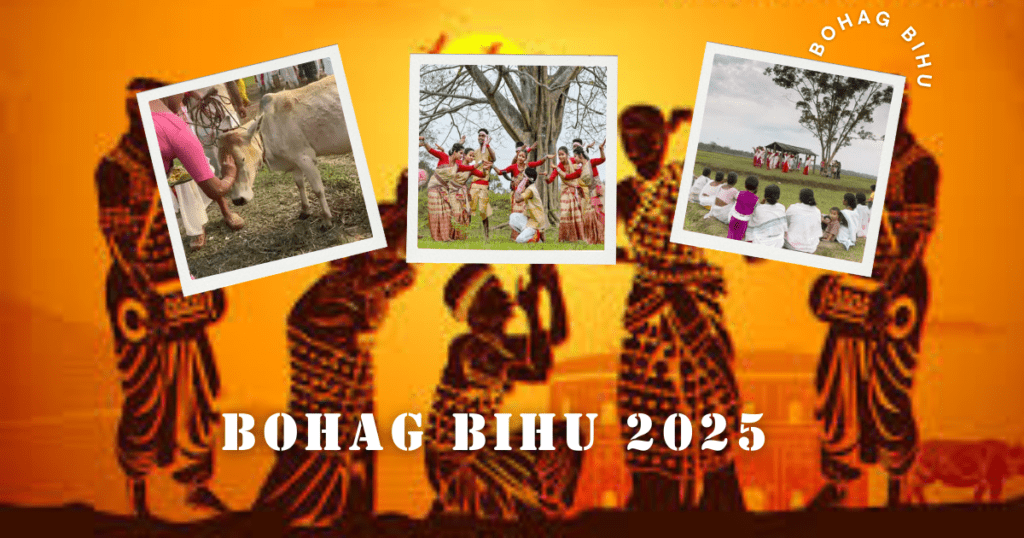
1. Goru Bihu (April 13, 2025)
This day is dedicated to cattle, which play a crucial role in farming. Farmers take their cows and buffaloes to nearby rivers or ponds, bathe them using turmeric and black gram paste, and worship them. Cattle are then adorned with garlands, and their sheds are cleaned and decorated. They are fed special food as a gesture of gratitude for their contribution to agriculture.
2. Manuh Bihu (April 14, 2025)
This day is for people, symbolizing a fresh start. Assamese families wake up early, take a ritualistic bath, and wear new clothes. Elders bless the younger members, and gifts are exchanged. Traditional Assamese attire such as mekhela chador for women and dhoti-kurta for men is worn with pride. Special delicacies like pitha (rice cakes), larus (sweets), and doi-sira (curd and flattened rice) are prepared and shared with family and friends.
3. Gosai Bihu(April 15, 2025)
Gosai Bihu is observed on the third day of Bohag Bihu and is dedicated to worshiping gods and ancestors. People offer prayers, apply maah-halodhi (black gram and turmeric paste), and seek blessings for a prosperous year. Traditional rituals include lighting lamps and offering pitha, laru, and betel leaves to deities.
4.Tator Bihu (April 16, 2025)
Tator Bihu is a special aspect of Bohag Bihu, celebrating Assam’s rich handloom tradition. During this time, Assamese women weave new gamosas and mekhela chadors as a symbol of love and respect. The festival highlights the skill of Assamese weavers, preserving the state’s cultural and textile heritage.
5. Nanglor Bihu (April 167, 2025)
Nanglor Bihu is an essential part of Bohag Bihu, symbolizing the agrarian roots of Assamese culture. It marks the beginning of the agricultural season, where farmers honor their plows (Nangol) and other farming tools. Rituals, prayers for a good harvest, and traditional celebrations make this an important aspect of Bihu.
6. Jiyori/Senehi Bihu (April 18, 2025)
Jiyori or Senehi Bihu is a special day during Bohag Bihu, dedicated to love and affection. On this day, young men express their feelings by gifting traditional Assamese handwoven gamusa or handmade gifts to their beloved. It is a celebration of romance, bonding, and cultural heritage.
7. Chera Bihu (April 19, 2025)
Chera Bihu marks the concluding day of Bohag Bihu, symbolizing reflection and renewal. Families gather to share meals, exchange good wishes, and discuss future plans. Traditional rituals are performed, seeking blessings for prosperity. It signifies the transition from celebrations to daily life, preserving the essence of unity and togetherness.
Bihu Dance and Music
Bohag Bihu 2025, the vibrant festival of Assam, is celebrated with joy, marking the Assamese New Year and the arrival of spring. Central to the festivities are the Bihu dance and music, where men and women, dressed in traditional attire, perform to the beats of the dhol, pepa, and gogona. The rhythmic movements and melodious Bihu songs create an electrifying atmosphere, reflecting Assam’s rich cultural heritage. Villages and cities come alive with performances, feasts, and community gatherings. This festival of Assam not only signifies agricultural prosperity but also strengthens bonds among people, making it a cherished celebration across the state.
Traditional Cuisine of Bohag Bihu
Rongali bihu, a vibrant Assamese festival, showcases Assamese cuisine with traditional delights like pitha, larus, doi, sira, maasor tenga, and tenga doi, reflecting Assam’s rich culinary heritage and cultural essence.
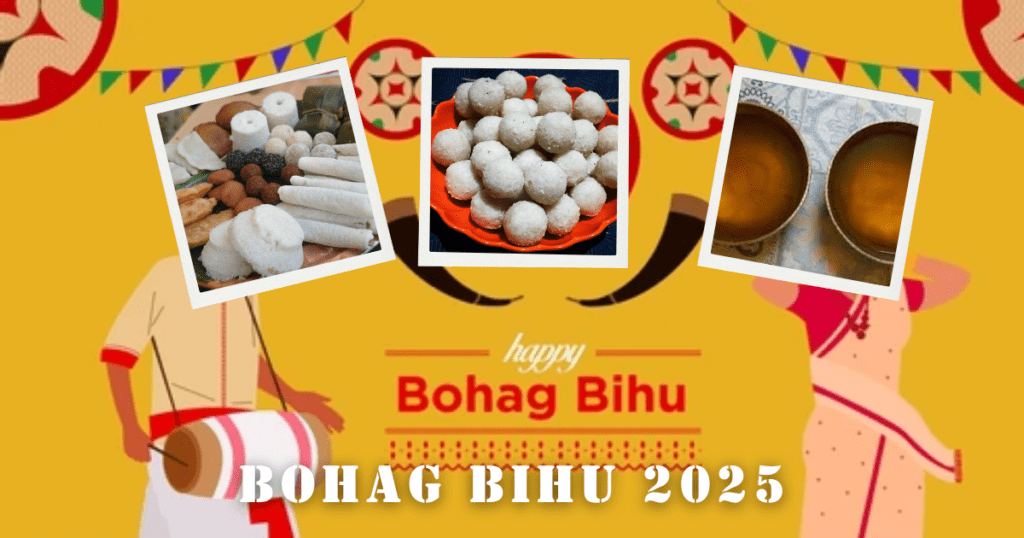
Pitha –
Pitha is an essential delicacy of Bohag Bihu, symbolizing Assam’s rich culinary heritage. These traditional rice cakes come in various forms, such as til pitha (stuffed with sesame and jaggery), narikol pitha (coconut-filled), and sunga pitha (steamed in bamboo). Made from rice flour, coconut, sesame, and jaggery, pithas are prepared with great care during the Bihu celebrations. They are not just festive treats but also a reflection of Assamese culture and hospitality. The preparation of pitha brings families together, adding warmth and joy to the Bohag Bihu festivities, marking the Assamese New Year with sweetness and tradition.
Laru –
Laru is a traditional Assamese sweet prepared during Bohag Bihu, the festival marking the Assamese New Year. These delicious sweet balls are typically made from coconut, sesame seeds, or puffed rice, mixed with jaggery or sugar. The mixture is shaped into small rounds, offering a rich, natural sweetness. Coconut Laru (Narikol Laru) and Sesame Laru (Tilor Laru) are the most popular varieties. Made with love, they symbolize warmth, prosperity, and togetherness. Laru is not just a delicacy but an integral part of Assamese culture, enjoyed during Bihu celebrations with family and friends.
Xaj Pani –
Xaj Pani is an integral part of Bohag Bihu, the vibrant Assamese New Year festival. This traditional rice beer, prepared by fermenting rice with a special mix of herbs, is a cherished drink among the Ahom community. It carries cultural significance, often served as a mark of hospitality and celebration. Xaj Pani has a smooth, mildly sweet taste and is believed to have medicinal benefits. During Bohag Bihu, it complements traditional Assamese feasts, enhancing the festive spirit. This heritage brew symbolizes joy, unity, and Assam’s rich culinary traditions, making it an inseparable part of the celebrations.
Masor Tenga –
Masor Tenga, a quintessential Assamese dish, holds a special place in Bohag Bihu celebrations. This tangy fish curry, traditionally prepared with Rohu or Catla fish, is cooked with tomatoes, lemon, or thekera (dried garcinia) to achieve its signature sour taste. Light yet flavorful, Masor Tenga is a refreshing dish, perfect for the warm spring season of Bihu. It is often enjoyed with steamed rice, enhancing its delicate flavors. Symbolizing Assam’s love for simple yet aromatic cuisine, Masor Tenga reflects the state’s deep connection with nature, seasonal ingredients, and the joyous spirit of Bohag Bihu.
Khar –
Khar is a unique and traditional Assamese dish, deeply rooted in the Bohag Bihu festivities. Made from sun-dried banana peel ash extract, it imparts a distinct alkaline flavor to dishes. Typically prepared with raw papaya, lentils, or bottle gourd, Khar is known for its cleansing and digestive properties. This simple yet flavorful dish is often enjoyed with steamed rice, setting the tone for a wholesome Assamese meal. Beyond its taste, Khar represents Assam’s rich culinary heritage, where indigenous ingredients and traditional cooking methods play a vital role in festive and everyday cuisine.
Community and Social Aspects
Bohag Bihu fosters a spirit of unity and joy. During the festival, people from all walks of life come together to celebrate, transcending social barriers. Various cultural organizations host public celebrations where artists, musicians, and performers showcase Assam’s heritage. The festival also serves as a platform for young talents to exhibit their skills in singing, dancing, and traditional crafts.
Significance and Traditions of Bohag Bihu 2025
Bohag Bihu, the Assamese New Year and harvest festival, symbolizes joy, prosperity, and the arrival of spring. Celebrated in mid-April, it unites communities through cultural traditions, feasts, and festivities. The festival begins with Goru Bihu, where cattle are bathed and honored, followed by Manuh Bihu, where people wear new clothes and seek blessings. Traditional Bihu dances, melodious folk songs, and community feasts highlight the celebrations. Local fairs showcase Assamese handicrafts, handloom, and traditional foods like pitha and laru. In 2025, Bohag Bihu continues to preserve Assam’s rich cultural heritage, fostering unity and happiness among people.
Bohag Bihu Beyond Assam
While Bohag Bihu is primarily celebrated in Assam, Assamese communities across India and the world observe it with great enthusiasm. Cities like Delhi, Mumbai, Bangalore, and even international locations like the U.S., U.K., and Australia host Bihu events where the Assamese diaspora gathers to relive their traditions and connect with their roots.
Tourism During Bohag Bihu
Bohag Bihu is an excellent time for tourists to visit Assam and experience its rich cultural traditions. Travelers can enjoy:
1. Bihu performances at cultural festivals and open-air stages.
2. Local fairs showcasing Assamese handicrafts, handloom products, and traditional food.
3. A visit to Assam’s scenic countryside, where one can witness the festival in its most authentic form.
Tourists can also explore Assam’s famous attractions such as Kaziranga National Park, Majuli (the world’s largest river island), and Sivasagar’s historical monuments while experiencing the festive spirit.
Environmental and Ethical Celebrations
With growing awareness about environmental conservation, efforts are being made to celebrate Bohag Bihu in an eco-friendly manner. People are encouraged to minimize waste, use biodegradable materials for decorations, and promote organic farming practices. Traditional practices like making pitha at home, using handloom gamochas, and avoiding plastic decorations are gaining popularity.
Top 10 FAQs About Bohag Bihu
What is Bohag Bihu?
Bohag Bihu, also known as Rongali Bihu, is the Assamese New Year festival celebrated in mid-April, marking the onset of the harvest season.
When is Bohag Bihu celebrated?
It is celebrated annually from April 13th to 15th, aligning with the Assamese New Year and the harvest cycle.
What are the main traditions of Bohag Bihu?
The festival includes cultural performances, Bihu dance, feasting, traditional sports, cattle-washing rituals, and community gatherings.
What is the significance of Bohag Bihu?
It symbolizes prosperity, agricultural abundance, and the renewal of life, bringing communities together in joyous celebrations.
What are the traditional foods of Bohag Bihu?
Assamese delicacies like pitha, laru, doi-sira, masor tenga, and khar are enjoyed during the festival.
What is the Bihu dance?
The Bihu dance is a vibrant folk dance performed by young men and women, accompanied by traditional music using instruments like the dhol and pepa.
How long does Bohag Bihu last?
While the main celebrations last for three days, festivities continue for around a month with various cultural events.
What are the different types of Bihu?
Assam celebrates three Bihus—Bohag Bihu (Rongali Bihu, in April), Magh Bihu (Bhogali Bihu, in January), and Kati Bihu (Kangali Bihu, in October).
How does Bohag Bihu impact tourism?
Bohag Bihu attracts tourists with cultural fairs, traditional performances, Assamese handicrafts, and festive feasts, offering a unique cultural experience.
How is Bohag Bihu different from other Indian harvest festivals?
Unlike Pongal, Baisakhi, or Makar Sankranti, Bohag Bihu is marked by its lively dance, music, and unique Assamese customs centered around community bonding and nature.
Conclusion
Bohag Bihu 2025 promises to be a grand celebration of Assamese culture, tradition, and unity. As one of the most joyous and colorful festivals of India, it offers a unique glimpse into Assam’s heritage and rural life. Whether you are an Assamese celebrating at home or a traveler looking to experience the festival’s vibrancy, Bohag Bihu is a time to embrace new beginnings, strengthen bonds, and immerse in the spirit of joy and festivity.

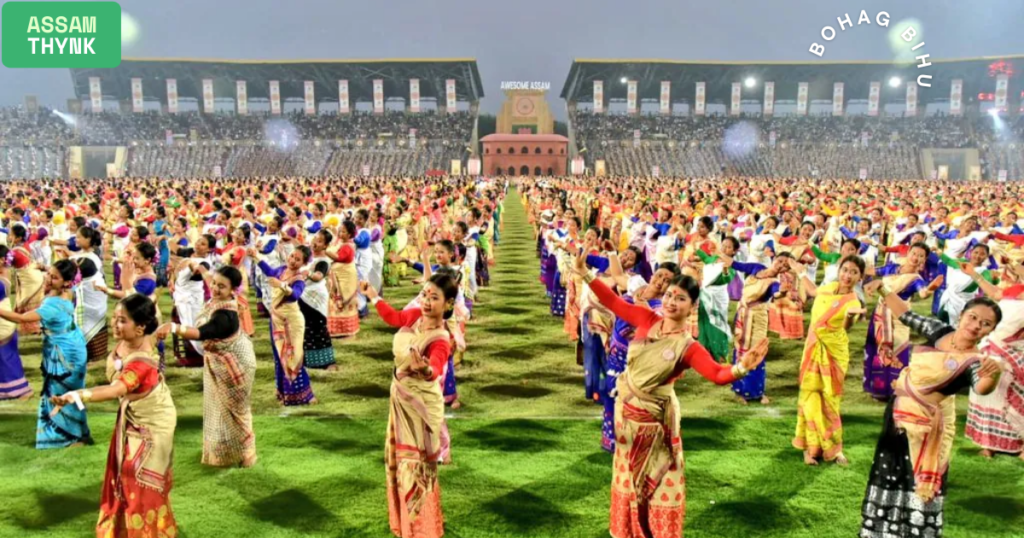
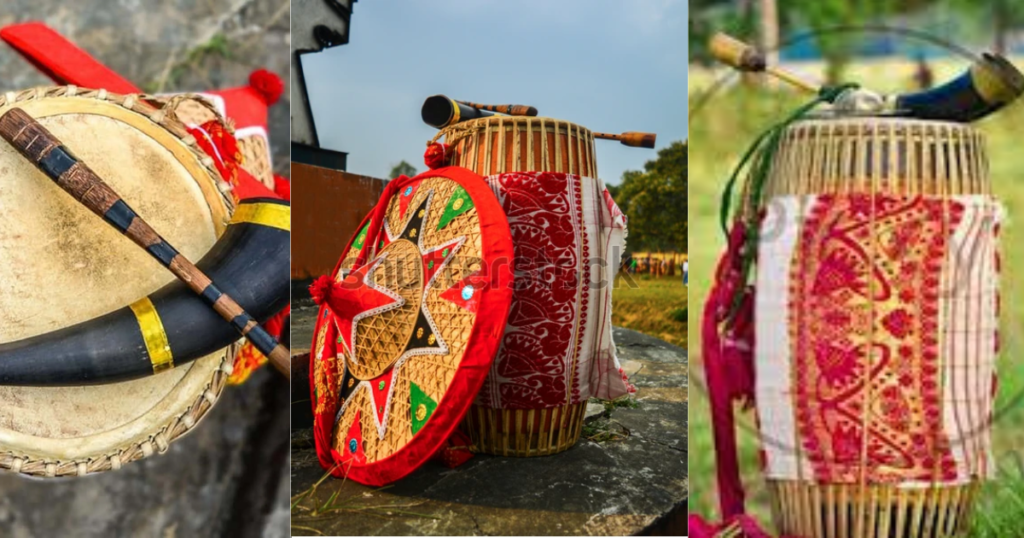

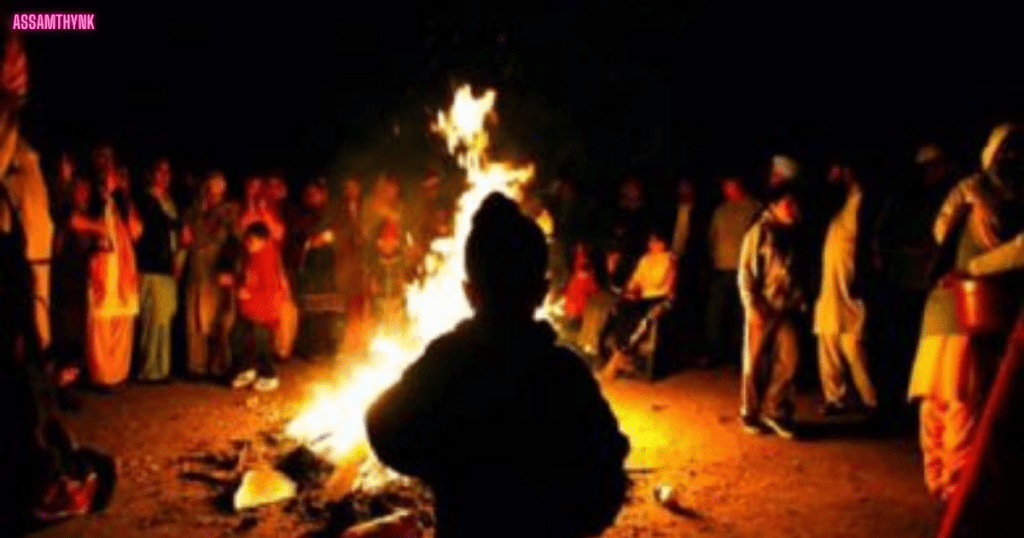
Pingback: Bihu Festival Of Assam: A Vibrant Celebration Of Culture And Life » Assamthynk
Pingback: Rongali Bihu 2025: Celebrating The Vibrant Bohag Bihu Festival Of Assam » Assamthynk